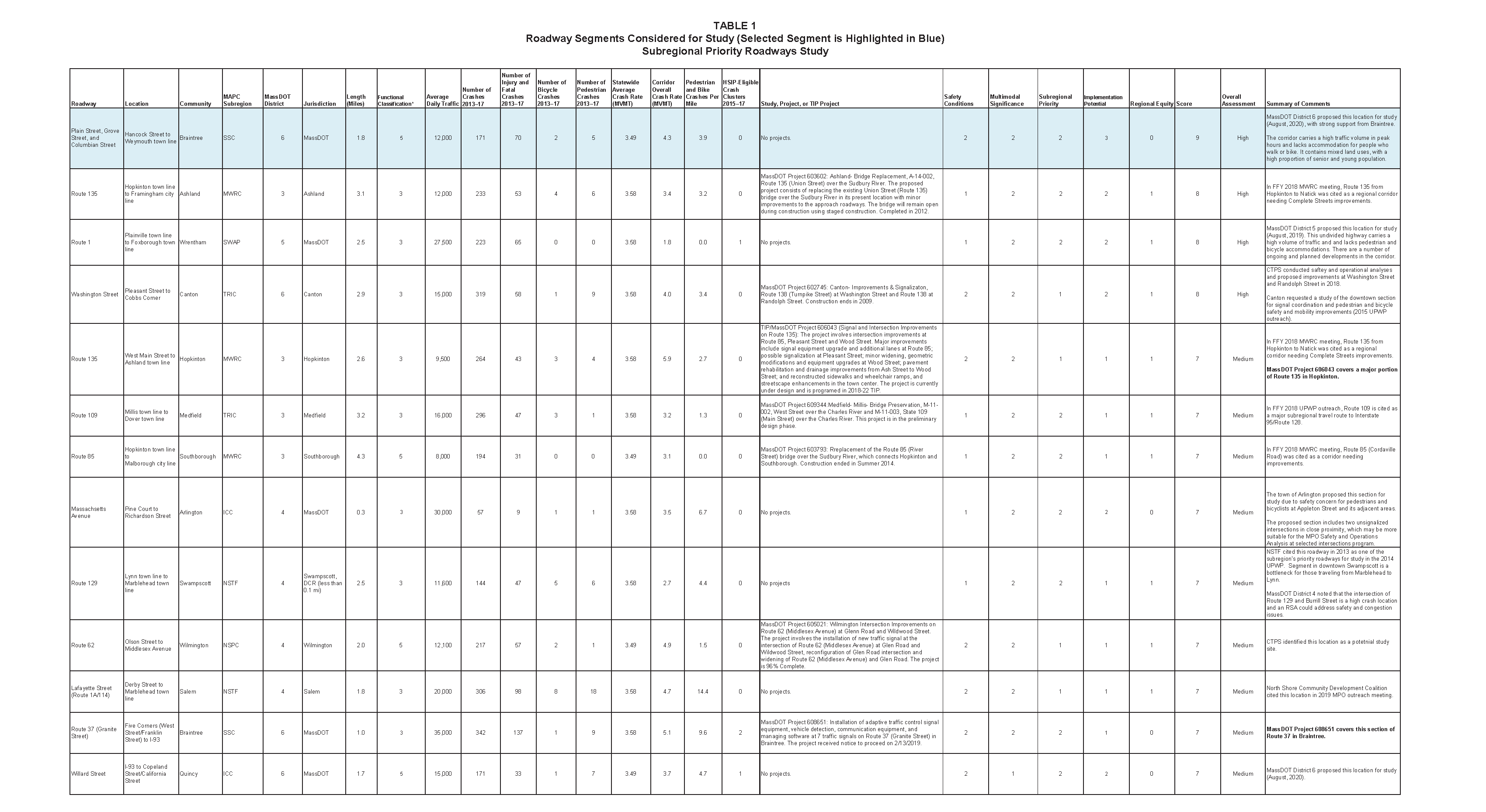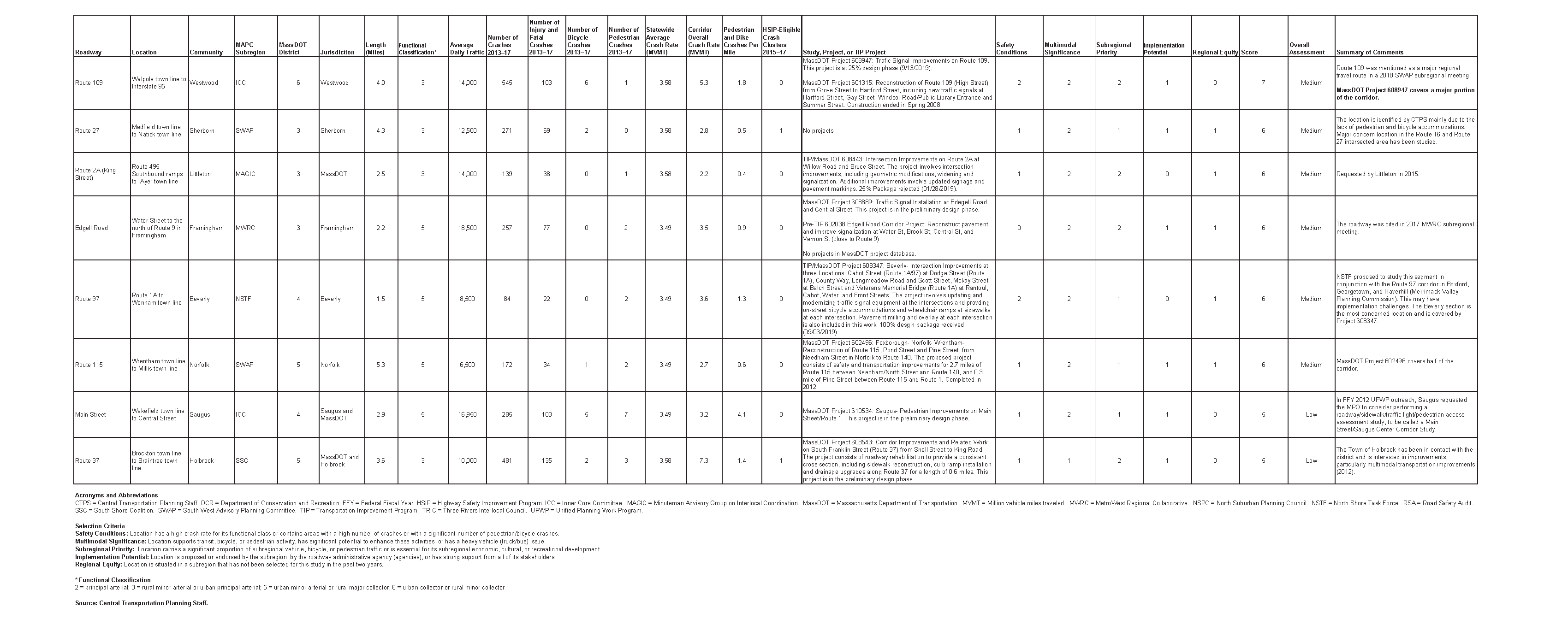

Technical Memorandum
DATE: December 17, 2020
TO: Boston Region Metropolitan Planning Organization
FROM: Chen-Yuan Wang, MPO Staff
RE: Selection of FFY 2021 Subregional Priority Roadway Study Location
During the Metropolitan Planning Organization’s (MPO) outreach to develop the Unified Planning Work Program (UPWP) and Long-Range Transportation Plan (LRTP), Metropolitan Area Planning Council (MAPC) subregional groups and other entities submit comments and identify transportation issues that concern them. Often, these issues are related to bottlenecks, safety, or lack of safe or convenient access to abutters along roadway corridors. They can affect not only mobility and safety along a roadway and its side streets, but also livability, quality of life, economic development, and air quality.
To address these concerns, MPO staff developed a work program titled Addressing Safety, Mobility, and Access on Subregional Priority Roadways. The program adheres to the following MPO goals.
The program has been well received by municipalities and the Massachusetts Department of Transportation (MassDOT) district offices and has been included in the UPWP since 2013, including this federal fiscal year (FFY) 2021.1 Another purpose of the study is to identify roadway segments in the MPO region that are of concern to subregional groups but have not been cited in the LRTP regional needs assessment.2
The study emphasizes issues identified by the relevant subregional groups, along with recommendations to address the identified issues. In addition to topics about mobility, safety, and access, it includes bicycle, pedestrian, and freight transportation, transit feasibility, and other subjects raised by subregional groups.
This memorandum presents the procedure used to select roadways for the study, including data gathering; selection criteria; roadway rating; the roadway corridor chosen for study; and a summary.
Selecting the study location comprised three steps:
MPO staff identified potential study roadways through various means:
MPO staff then assembled the following detailed data for these roadways:
Locations with projects that currently are under construction, in design, under study, or programmed in the TIP were excluded from further consideration. After the exclusion, MPO staff identified 21 potential roadway segments in the region. Table 1 presents data assembled for each roadway segment and indicates municipality, MAPC subregion, MassDOT district office, jurisdiction, length, functional class, average daily traffic, overall crash rates, bicycle/pedestrian crashes per mile, Highway Safety Improvement Program (HSIP)-eligible crash clusters, 3 and any relevant studies or projects. It also cites results of applying the selection criteria, and priority rating. Roadway segments are sorted by score, MassDOT District, and roadway name.
MPO staff examined roadway locations more closely and prioritized locations by applying a score based on safety conditions, multimodal significance, subregional priority, implementation potential, and regional equity.
Roadway segments with a score of five points or fewer were rated as low priority. Roadway segments with a score of six to seven points were rated medium priority. Roadway segments with a score of eight or more points were rated high priority. Among the 21 potential locations, MPO staff identified four as high priority:
Staff also evaluated the pedestrian accommodation and safety improvement needs for the four locations by applying the MPO’s Pedestrian Report Card Assessment.5 All four locations qualify highly for pedestrian accommodation or safety improvement requirements. Appendix A contains detailed results of the assessments.
MPO staff recommends Plain Street, Grove Street, and Columbian Street in Braintree for this study cycle, based on the following considerations:
Figure 1 shows the locations of this study and the previously studied corridors in the region. The selected corridor is approximately 1.8 miles in total length. All the segments in the corridor are classified as Urban Minor Arterial and are under MassDOT jurisdiction.
The selected roadways belonged to the “Old Route 128” corridor, which runs parallel to Interstate 93 and Route 3 and carries regional and local traffic. The corridor contains various land uses, including large-scale shopping plazas and street-front commercial developments, senior living residential developments, multi-unit condos and apartments, and single-family residences. Meanwhile, there are a number of ongoing and planned developments in the corridor.
MassDOT Highway Division District 6 recommended this roadway for study to explore Complete Streets needs and safety improvements for all users of the roadway, especially for those who walk. The Town of Braintree expressed that residents and locals have been concerned about this corridor because of the high crash rate and crashes caused by high vehicle travel speeds. Support letters for this study from the Town’s representatives and the mayor are included in Appendix B.
The selection of this corridor meets the objectives of this study. Meanwhile, it will support the MPO goals by improving subregional transportation safety and mobility and promoting regional economic vitality.
MPO staff will submit this proposal to the MPO for discussion and approval. If the MPO approves this selection, staff will meet with officials from Braintree, MassDOT, and MAPC to discuss the study specifics, conduct field visits, collect data, and perform various analyses.
The Boston Region Metropolitan Planning Organization (MPO) operates its programs, services, and activities in compliance with federal nondiscrimination laws including Title VI of the Civil Rights Act of 1964 (Title VI), the Civil Rights Restoration Act of 1987, and related statutes and regulations. Title VI prohibits discrimination in federally assisted programs and requires that no person in the United States of America shall, on the grounds of race, color, or national origin (including limited English proficiency), be excluded from participation in, denied the benefits of, or be otherwise subjected to discrimination under any program or activity that receives federal assistance. Related federal nondiscrimination laws administered by the Federal Highway Administration, Federal Transit Administration, or both, prohibit discrimination on the basis of age, sex, and disability. The Boston Region MPO considers these protected populations in its Title VI Programs, consistent with federal interpretation and administration. In addition, the Boston Region MPO provides meaningful access to its programs, services, and activities to individuals with limited English proficiency, in compliance with U.S. Department of Transportation policy and guidance on federal Executive Order 13166.
The Boston Region MPO also complies with the Massachusetts Public Accommodation Law, M.G.L. c 272 sections 92a, 98, 98a, which prohibits making any distinction, discrimination, or restriction in admission to, or treatment in a place of public accommodation based on race, color, religious creed, national origin, sex, sexual orientation, disability, or ancestry. Likewise, the Boston Region MPO complies with the Governor's Executive Order 526, section 4, which requires that all programs, activities, and services provided, performed, licensed, chartered, funded, regulated, or contracted for by the state shall be conducted without unlawful discrimination based on race, color, age, gender, ethnicity, sexual orientation, gender identity or expression, religion, creed, ancestry, national origin, disability, veteran's status (including Vietnam-era veterans), or background.A complaint form and additional information can be obtained by contacting the MPO or at http://www.bostonmpo.org/mpo_non_discrimination.
To request this information in a different language or in an accessible format, please contact
Title VI Specialist
Boston Region MPO
10 Park Plaza, Suite 2150
Boston, MA 02116
857.702.3700 (voice)
617.570.9193 (TTY)
1 Unified Planning Work Program, Federal Fiscal Year 2021, endorsed by the Boston Region Metropolitan Planning Organization on July 16, 2020.
2 Boston Region MPO Work Program for Addressing Priority Corridors from the Long-Range Transportation Plan Needs Assessment: Federal Fiscal Years 2012–20.
3 HSIP-eligible crash clusters are defined by MassDOT as crash clusters that rank within the top five percent of crash clusters for each Regional Planning Agency, based on the Equivalent Property Damage Only (EPDO) index. In the EPDO index, property-damage-only and severity unknown crashes are awarded one point each, fatal crashes and crashes involving injuries are given 21 points each. In the Boston Region MPO, 452 intersections are identified from MassDOT 2015–17 Crash Data as the top five percent crash clusters with a minimum EPDO value of 114.
4 Sufficient pedestrian accommodation is defined as more than 80 percent of the roadway containing minimal five-foot sidewalks in both directions, and sufficient bicycle accommodation as more than 80 percent of the roadway containing minimal five-foot shoulders (or bicycle lanes) in both directions.
5 Ryan Hicks and Casey-Marie Claude, Pedestrian Level-of-Service Memorandum, Boston Region Metropolitan Organization, January 19, 2017.


